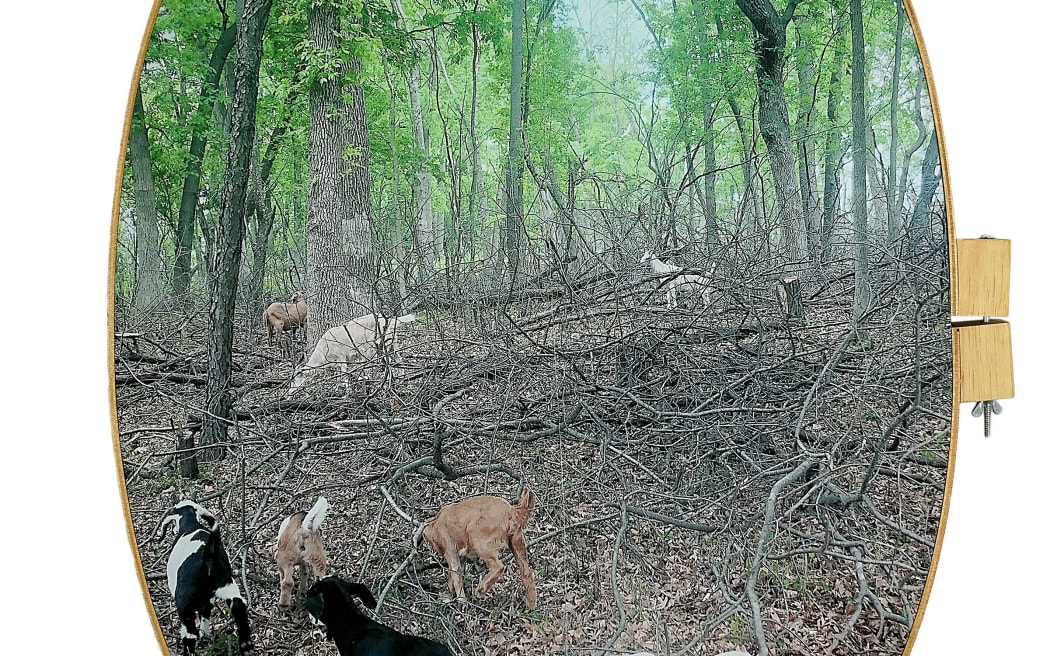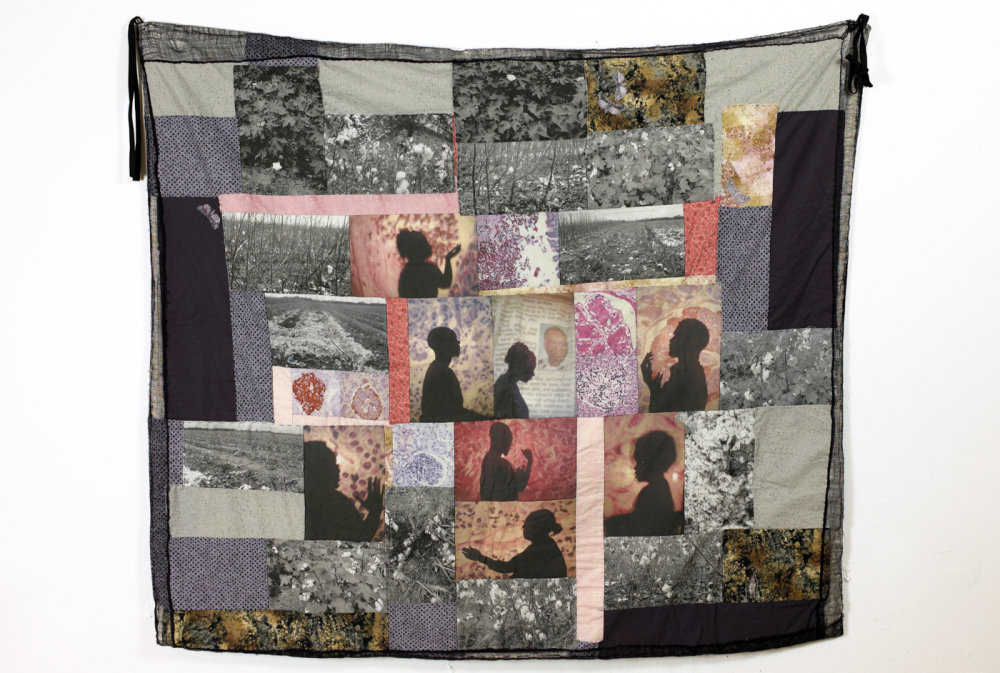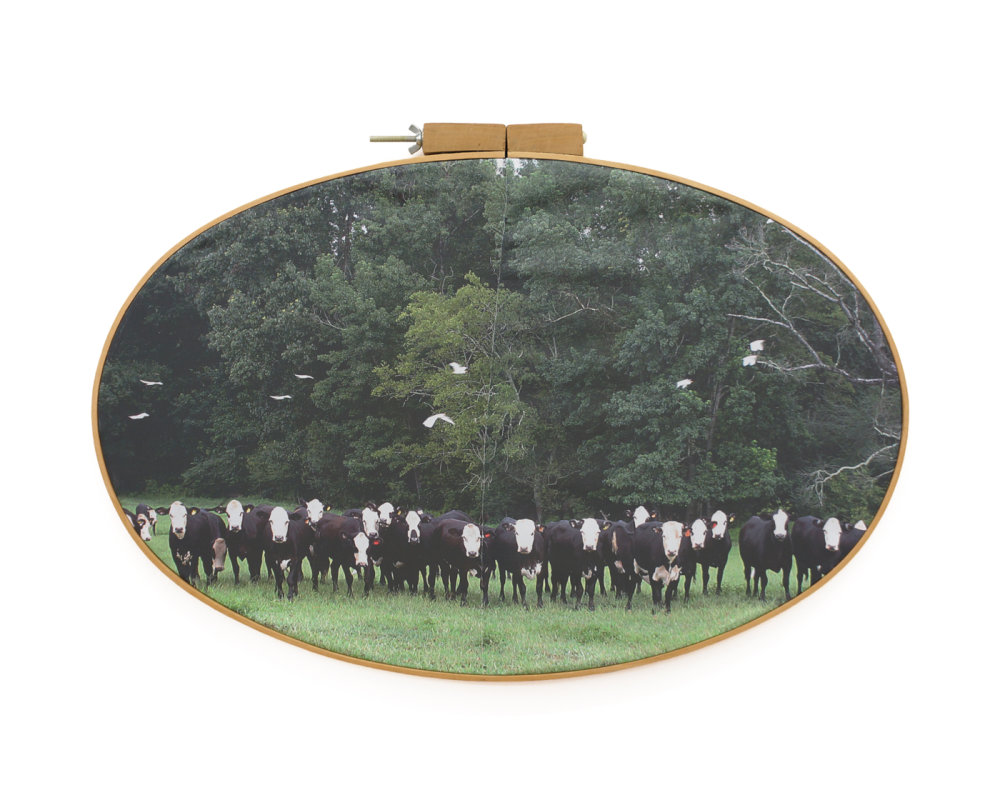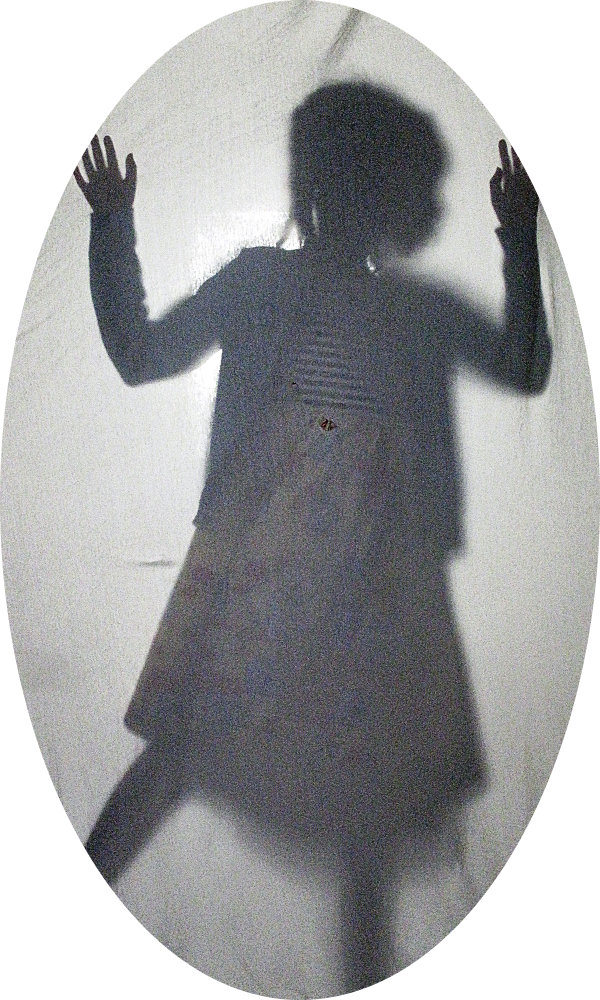
Letitia Huckaby creates unique objects using photography printed onto non-traditional material. “Beautiful Blackness” includes several components that follow the tradition of visual storytelling. The work is a combination of people, land and tradition. Letitia is a deeply religious and thoughtful person. The materials on which she prints—flour sacks, sugar sacks, cotton fabric that is either sewn to create quilts or framed with vintage wood embroidery hoops, as well traditional prints—carry a history that connects past to present. Huckaby’s visual expression is a fine balance of who she is—a documentary photographer and artist.
Letitia Huckaby grew up with cherished family roots in the deep southern United States. In an interview with Hamidah Glasgow for Strange Fire Collective (May 30, 2019), Huckaby spoke about her past: “After studying and gaining degrees in both journalism and photography, some of my first works were naturally photojournalistic. A voyeur documenting the lives of others, but with the loss of my father, I became interested in doing more personal work. For the first time, I turned the camera on myself and my family. … There is always a history built into the pieces, whether through process or actual materials. … I love pushing the boundaries of photography, by using a traditional practice in a non-traditional way and hopefully creating a new visual language.”
The exhibition “Beautiful Blackness” is comprised of newly created pieces inspired by some of Huckaby’s earlier work. Prior work includes “40 Acres..Gumbo Ya Ya,” “Bayou Baroque,” “LA 19,” and “Quilts.” In “Cotton Pests and Diabetes,” a quilted work, Huckaby’s passion for the land and people are intertwined. Nature and humans alike mold what we see today in a landscape. What happened in a place? What hints are there in the image? What is seen in the present can evoke different emotions, including awe, fear, beauty, desire, and connectedness. What stories lie below the visual surface? How has a plot of land been sculpted to become what it is today? Through natural forces of wind and rain, flood and drought, heat and cold, or through the forces of men and animals, war and construction?
The construction of quilts is both an individual as well as a community effort. The quilts are “hand-stitched together into traditional African-American quilting patterns.” The landscapes have no evidence of people, and rarely animals. In “Cotton Pests,” there are both. Land and People, together. The people are shown as black silhouettes – both young and old, multiple generations. Each person conveys an emotion. Reflections, prayers, and innocence. Then there is the landscape. Images of fields, forests, and cotton plants. The fabric is plain and basic and does not compete with the images. Huckaby seems to want us to move visually in and around the images. The fabric is almost like the base soil itself, and also the sky, as the fabric features hues of grey and blue. In the center there appears an obituary for a man with the last name of Jenkins, which is Huckaby’s maiden name. In a way, the quilt seems dedicated to him. The viewer assumes that there is a connection between the people who are silhouetted, and Oliver Jenkins. The silhouette directly over the obituary may indeed be the artist herself. The land and the cotton are a reflection on her family’s connection to a joint history and journey.

© Letitia Huckaby, Cotton Pests and Diabetes (2007)
Her portraits speak to family and friends, devotion, compassion, and her sense of heritage as an African American with a shared history of slavery and deep religious belief. That personal history links back to the freed slaves after the civil war, which ended April 9, 1865, and who migrated away from the deep south around 1879. The people of this exodus were call “Exodusters,” as a reference to a search for something better, like the Hebrews in Egypt leaving the oppression of the Pharaohs for the promised land lead by Moses. Letitia Huckaby describes “Beautiful Blackness” as “a visual pilgrimage following the path of Exodusters, African Americans who migrated from states along the Mississippi River to Kansas and Oklahoma in the late nineteenth century, and an exploration of the remains of Freeman’s towns across the south. It is an elegy for a lost promised land. Landscapes and figurative works combine to depict an exodus, a people and what remains of their hopes and dreams.” Much of the migration came out of Louisiana where Huckaby has her family roots, and up into Kansas, Colorado and Oklahoma. In a nod to this major episode in African American history, Huckaby created the portfolio “40 Acres and a mule”. The genesis for this was “Special Field Order No. 15 (1/16/65)” issued by Union General William Tecumseh Sherman that freed slaves should be allowed the use of 40 acres of land (although mules are not mentioned) in the South Carolina, Georgia and Florida areas, yet the order was later reversed by President Andrew Johnson [Wikipedia]. As a historical reference, slavery is thought to have first started in the United Sates in 1619, and was officially ended and prohibited by the 13th Amendment (One of three amendments to the US Constitution—the 13th (ending slavery), the 14th (granting citizenship and equal protection), and the 15th (granting the right to vote regardless of race, color or previous condition of servitude) which were passed between 1868 and 1870. A two hundred fifty year legacy remained and would continue to shape American history for much longer.

© Letitia Huckaby, Dixon Correctional (2017)
There are hidden stories on landscapes that go beyond what we see. In driving past the “Dixon Correctional,” a prison facility in Jackson, Louisiana, Huckaby caught a glimpse of this line up of cows. This image is from her series “40 Acres…Gumbo Ya Ya.” She quickly stopped the car to capture this image. The black cows made her think of the number of black incarcerated inmates, and the white faces a stark contrast. It is a beautifully striking image that has an innocence and very familiar feel to what we expect to see in a rural area. Huckaby saw a different message in this scenery. The white birds flying over head, in supervision in and amongst the cows, is another subtle reference back to the African American experience. It references the post-civil war effort to stabilize and simultaneously police a slave community with new found freedom. The expression “Gumbo Ya Ya” refers, as Huckaby describes, as everyone talking at once and not saying anything. For her, the title is a reference to a felt inaction and unfulfilled commitment to the African-American community.
With Huckaby’s landscapes and portrait images, understanding her perspective and life experience gives a greater richness to the images for the viewer. While there is no hint that these cows are on the property of a correctional facility cared for by the inmates, she knew. Sometimes, to fully appreciate the work of an artist, we need to be given some additional information about an image. Where was it taken, and what made it important for the artist to capture and present? How is the image presented to the viewer to give context and appreciation as an art object? Once Huckaby’s background is understood, the image speaks rather loudly. The artist’s point of view in this case takes over, and the art practically cannot be considered outside of its context.

© Letitia Huckaby, Sweet Enough (2020)
The image “Sweet Enough” stands as an example of Huckaby’s new work which conveys both motion and emotion. It is one of a series of portraits that carries forward her prior, unique work from the portfolios “Shop Rags,” “Sugar Sacks,” and “Flour”. In “Sweet Enough,” a young girl is positioned as if pressing up against the fabric on which the image is printed. She appears encased in a bubble looking for a way forward, as if exiting a room. Her head is turn to her left in inquiry. The hands are held up and are so very delicate in their touch against the cloth. Yet, in the profile of her face, there is the slightest sense of seriousness and questioning. The shadow at the bottom of her dress lends a sense of motion to the image. It is not that the little girl is stiff and rigid. It seems more that she is only momentarily stopped, preparing for a next move. Despite this, the initial reaction it creates is light hearted and whimsical. The use of cotton fabric is Huckaby’s reference, once again, to the connection to the land worked by slaves, the south, and family memory. The artist is also a deeply religious person. The young girl’s dress looks like the sort that would be worn on Sunday to church services. Her hair all nicely done. You can just make out the lines in her shirt, but no facial details. This allows the viewer’s imagination to wander and engage in their own reflections and thoughts as if they, themselves, are that same age. In a way, the embroidery hoop is a looking glass into the past. The roundness of the hoop is a hole in time for the viewer to step through into some past moment.
Our varying life experiences inspire different thoughts and emotions while looking at this and others of Huckaby’s images. It challenges our biases. Do we immediately recognize this young girl as African American? Despite a lack of specific facial features, is it concerning that the outline of the face might make us think of ethnicity? Would that be the case for anyone else with a different background and heritage? Does the way her hair is outlined against the fabric suggest clues as to where this girl family may have lived and what they may have experienced? Somehow, the image triggers a recognition. It does not give any clue as to whether the she lives in the northern, eastern, western, or southern parts of the United States, or whether she lives in the US at all. How does the viewer’s background affect their engagement with the image? If we are from the north, how would our engagement with the image differ than if we are from a southern state? While image titles can be informative, do they bias how we appreciate and read the photograph? Huckaby’s title “Sweet Enough” implies the delight and wonder we all feel with young people just simply enjoying life, playing, and unencumbered by all we come to learn as adults as we engage with each other in an evolving set of rules and customs.

© Letitia Huckaby, The Rising Sun (2020)
“The Rising Sun,” like “Sweet Enough,” is part of the new works of “Beautiful Blackness,” yet is a very different approach in Huckaby’s portraiture. The shadowed image of a young boy appears against a very colorful background which is backlit. The viewer clearly sees a young African-American boy. Does the color of his skin make a difference in how we read this image if we are Anglo, Asian, Hispanic, or African American? We see his features and expression, but in a most subtle and gentle way. This young person’s eyes are wide open and looking straight at the viewer. The gaze is unflinching. His lips are closed, and his face feels totally relaxed. It is a different look into the future. It’s an expression of innocent expectations. The expression is one of inquiry and questioning. At the same time, it is welcoming and unworried. The title “The Rising Sun” provided by Huckaby directs our thoughts through a play on words: “son” and “sun.” It raises new questions of what an image says. We know he is someone’s son. The light in the back could indeed be from a rising sun. Within the composition, does the light behind imply that Huckaby wants us to reflect on a new day?
In a sense, Huckaby’s image “The Rising Sun” is literally capturing a moment in time, yet it is not about a moment in time. If an image is documentary, it records an event, as Roland Barthes might argue in his book “Camera Lucida.” This image, as with other work by Huckaby, seems to place this young boy is a space moving through time. Why is that? It is the use of light. Because the image is backlit, and the face of the boy recedes into shadow, the image is not literally a portrait of a person. We use portraits to record a loved one and hold the image dearly through time to recall that age, time, and place. Instead, this image could be more of a place holder for either all young people of that age, or more specifically all young men of that age. If the image is freezing our attention on a young African American boy, and Huckaby’s intent is about the future and not the present, then we can read this image very differently. The image then becomes all about what our expectations are for this youngster. Huckaby is capturing, through printing on cotton, this person’s past heritage. The embroidery hoop may function as a symbol of how heirlooms are created and of tradition, connection to family and heritage passed from generation to generation. If so, the bright colorful background gives a sense of joyousness. The viewer may feel elation and hold a message that is positive and full of hope that this son is rising into a new and different future.
Letitia Huckaby’s landscapes and portraits in “Beautiful Blackness” are more than captured images; these are objects of art which speak to legacy. Going beyond recording in a documentary fashion, she has made the object a tool for communication, expression, and statement. Her degree in Journalism from the University of Oklahoma, with a BFA from the Art Institute of Boston in photography and a Master’s degree from the University of North Texas in Denton provides a background for her unique craftsmanship and the methods with which she builds her stories on fact and composition and material. While it is beneficial to know that the landscapes are in Louisiana, Mississippi, Kansas, and Texas, what is more relevant is the open agricultural and rural environment that sets a stage for her expression. We know it is not an urban or suburban setting. It is the country, not complicated in the same ways as the city. Printing on cotton cloth framed in symbolic wooden embroidery hoops, on quilted cloth, or, as in Huckaby’s previous series of work, flour sacks and sugar sacks, is an act which literally embeds a deeper visual message as the product of land and labor. The material on which these images are printed is from the earth. This is a hint of the heritage which Huckaby is referencing. The single composition or combination of images on a quilt are the visual storyline from a past to the present fixed to this land. The use of silhouettes in “Beautiful Blackness” is about age, context, and place more than who the people are in these images. The use of both landscape and silhouette allow a viewer to imagine themselves floating through this shared personal history. For Letitia Huckaby, her work “is a time capsule for the African-American experience.”